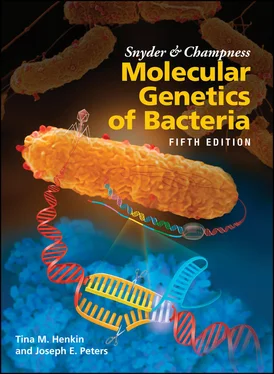Before the advent of methods for manipulating DNA in the test tube, the only genetic approaches available for studying cellular and organismal functions were those of classical genetics. In this type of analysis, mutants (i.e., individuals that differ from the normal, or wild-type, members of the species by a certain observable attribute, or phenotype) that have alterations in the function being studied are isolated. The changes in the DNA, or mutations, responsible for the altered function are then localized in the chromosome by genetic crosses. The mutations are then grouped into genes to determine how many different genes are involved. The functions of the genes can then sometimes be deduced from the specific effects of the mutations on the organism. The ways in which mutations in genes involved in a biological system can alter the biological system provide clues to the normal functioning of the system.
Classical genetic analyses continue to contribute greatly to our understanding of developmental and cellular biology. A major advantage of the classical genetic approach is that mutants with an altered function can be isolated and characterized without any a priori understanding of the molecular basis of the function. Classical genetic analysis also is often the only way to determine how many gene products are involved in a function and, through suppressor analysis, to find other genes whose products may interact either physically or functionally with the products of these genes.
The development of molecular genetic techniqueshas greatly expanded the range of methods available for studying genes and their functions. These techniques include methods for isolating DNA and identifying the regions of DNA that encode particular functions, as well as methods for altering or mutating DNA in the test tube and then returning the mutated DNA to cells to determine the effect of the mutation on the organism.
The approach of first cloning a gene and then altering it in the test tube before reintroducing it into the cells to determine the effects of the alterations is sometimes called reverse geneticsand is essentially the reverse of a classical genetic analysis. In classical genetics, a gene is known to exist only because a mutation in it has caused an observable change in the organism. With the molecular genetic approach, a gene can be isolated and mutated in the test tube without any knowledge of its function. Only after the mutated gene has been returned to the organism does its function become apparent.
Rather than one approach supplanting the other, molecular genetics and classical genetics can be used to answer different types of questions, and the two approaches often complement each other. In fact, the most remarkable insights into biological functions have often come from a combination of classical and molecular genetic approaches.
In bacterial genetics, genetic techniques are used to study bacteria. Applying genetic analysis to bacteria is not different in principle from applying it to other organisms. However, the methods that are available differ greatly. Some types of bacteria are relatively easy to manipulate genetically. As a consequence, more is known about some bacteria than is known about any other type of organism. Some of the properties of bacteria that facilitate genetic experiments are described below.
One of the major advantages of bacteria for genetic studies is that they are haploid. This means that they have only one copy, or allele, of each gene. This property makes it much easier to identify cells with a particular type of mutation.
In contrast, most eukaryotic organisms are diploid, with two alleles of each gene, one on each homologous chromosome. Most mutations are recessive, which means that they do not cause a phenotype in the presence of a normal copy of the gene. Therefore, in diploid organisms, most mutations have no effect unless both copies of the gene in the two homologous chromosomes have the mutation. Backcrosses between different organisms with the mutation are usually required to produce offspring with the mutant phenotype, and even then, only some of the progeny of the backcross have the mutated gene in both homologous chromosomes. With a haploid organism such as a bacterium, however, most mutations have an immediate effect and there is no need for backcrosses.
Another advantage of many bacteria for genetic studies is that they have very short generation times. The generation timeis the length of time the organism takes to reach maturity and produce offspring. If the generation time of an organism is too long, it can limit the number of possible experiments. Some strains of the bacterium E. coli can reproduce every 20 minutes under ideal conditions. With such rapid multiplication, cultures of the bacteria can be started in the morning, and the progeny can be examined later in the day.
Another advantage of bacteria is that they multiply asexually, by cell division. Sexual reproduction, in which individuals of the same species must mate with each other to give rise to progeny, can complicate genetic experiments because the progeny are never identical to their parents. To achieve purebred lines of a sexually reproducing organism, a researcher must repeatedly cross the individuals with their relatives. However, if the organism multiplies asexually by cell division, all the progeny are genetically identical to their parent and to each other. Genetically identical organisms are called clones. Some simpler eukaryotes, such as yeasts, and some types of plants, such as water hyacinths, can also multiply asexually to form clones. Identical twins, formed from the products of the division of an egg after it has been fertilized, are clones of each other. While there are a few examples where mammals have been cloned by transplanting a somatic cell into the ovary, bacteria form clones of themselves every time they divide.
Colony Growth on Agar Plates
Genetic experiments often require that numerous individuals be screened for a particular property. Therefore, it helps if large numbers of individuals of the species being studied can be propagated in a small space.
With some types of bacteria, thousands, mill ions, or even bill ions of individuals can be screened on a single agar-containing petri plate. Once on an agar plate, these bacteria divide over and over again, with all the progeny remaining together on the plate until a visible lump, or colony, has formed. Each colony is composed of millions of bacteria, all derived from one original bacterium and hence all clones of the original bacterium.
The ability of some types of bacteria to form colonies through the multiplication of individual bacteria on plates allows colony purification of bacterial strains and mutants. If a mixture of bacteria containing different mutants or strains is placed on an agar plate, individual mutant bacteria or strains in the population each multiply to form colonies. However, these colonies may be too close together to be separable or may still contain a mixture of different strains of the bacterium. If the colonies are picked and the bacteria are diluted before replating, discrete colonies that result from the multiplication of individual bacteria may appear. No matter how crowded the bacteria were on the original plate, a pure strain of the bacterium can be isolated in one or a few steps of colony purification.
Читать дальше











